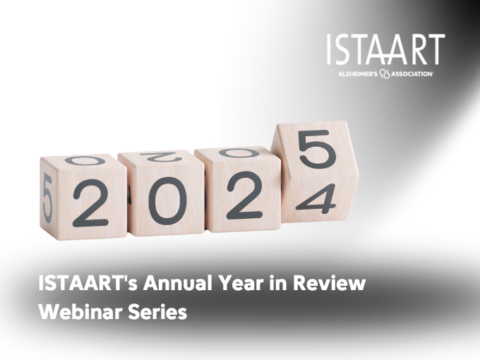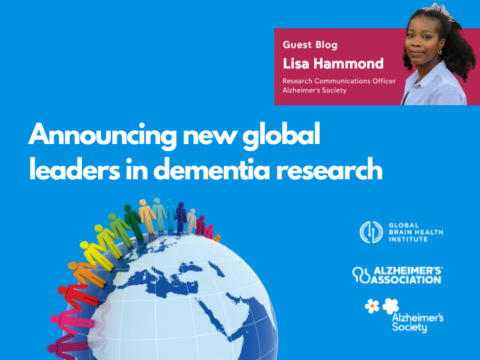Did you know that the eye is kind of a window into your brain? The eye is becoming a very interesting research tool to investigate Alzheimer’s disease because the retina (at the back of your eye) is actually an extension of the central nervous system. Anyway, before I get too excited about this, this blog will highlight some of the most impactful papers in this research field from 2023, brought to you by the eye as a biomarker professional interest area group.
Okay, I’ve already told you about the cool connections between the eye and the brain. But, I’d like to tell you a little more. Not only does part of the eye connect to the brain, but the retina also shares cellular and anatomical similarities to the brain. And, importantly, research has shown that many pathological hallmarks of Alzheimer’s disease observed within the brain are also found within the retina, such as amyloid accumulation.
As with all the year in review webinars, a member of the PIA presents some of the most influential papers of the field that were published in the past year. PhD student Yasmin Dahdouh- Guebas was the presenter this year, and they gave a fantastic overview of the most impactful papers published in 2023. The moderator of the session was Lies De Groef and the panellists were Jessica Alber, Robert Rissman and Dietmar Thal.
Over the past decade, the field has really grown. Yasmin highlighted areas in which the field had grown and importantly revealed that there has been an increase in gender equality in these studies, an increase in ethno-diverse studies and an increase in comparative/biomarker studies being published. As there were so many papers published in 2023 about the eye and Alzheimer disease, they obviously couldn’t all be highlighted. However, Yasmin split the research focuses into 4 main categories, and highlighted key papers within each. The four categories were as follows: correlation studies, biomarker studies, preclinical studies and tauopathy studies.
One important correlation study that was highlighted aimed to get a better understanding of pathological features of AD within the retina, using histopathological and biochemical assessment of post mortem tissue. In this study Koronyo and colleagues included both mild cognitive impairment (MCI) and clinically diagnosed AD patients and compared these to individuals with normal cognition. The study found increases in AB42 within the retina in both MCI and AD patients, compared to individuals with normal cognition. The amount they observed within the retina seemed to mirror the amount observed within the brain. They also found that the pathology observed within the retina appeared to correspond to Braak staging. The group concluded that the retina is susceptible to AD changes. Moreover, it is suggested that the retina could indeed be a reliable biomarker, for non-invasive detection and also monitoring of AD.
The same research group also investigated vascular changes in the retina – as vascular changes are often observed in AD. They investigated endothelial tight junction components and cerebral amyloid angiopathy (CAA) in post mortem retinas in different types of blood vessels in MCI, AD patients and compared this to controls who were cognitively normal. They reported that there were decreases in tight junction components, including zonula occludens-1 (ZO-1) and claudin-5 in both MCI and AD patients. Interestingly, they reported that decreases in claudin-5 were linked with CAA and decreases in ZO-1 seemed to correlate more with cognitive changes and pathology within the brain. The group concluded that the retina is also susceptible to vascular changes associated with AD and that imaging of blood vessels within the retina could also be helpful in monitoring AD.
With regards to biomarkers, the retina could be a very important avenue for biomarker development for AD, because the retina is easily accessible with non-invasive high-resolution imaging equipment (just like the equipment that’s used at an optician’s appointment). As research seems to show that the pathology associated with AD does indeed develop in the retina, this sort of equipment may be able to observe this early in disease. To investigate whether this was possible, Arthur and colleagues wanted to investigate whether optical coherence tomography could be used to assess blood vessel changes in cognitively unimpaired, low risk and high-risk patients. This study showed that multimodal retinal imaging could be a potential biomarker for early detection of AD as the group observed that the periarteriole capillary free zone in the high-risk group was significantly larger that the low-risk group. The same observations were also observed for the perivenule capillary free zone.
Another biomarker study that was highlighted in the webinar was conducted by Rebouças and colleagues. Importantly, this was a longitudinal study that investigated retinal microvasculature and the incidence of dementia over a period of 10 years. The study looked at sociodemographic characteristics as well as lifestyle, physical and mental health, cognitive function and ophthalmic history. These measurements were taken every 2 to 3 years for up to 17 years. The authors found that 21.9% of the sample developed dementia. They observed that an increase in the tortuosity of arteries in the retinal vasculature was associated with an increased risk of dementia in the 10 years that followed. Moreover, they also observed that higher vein tortuosity and a broader retinal caliber was associated with vascular/mixed dementia, but not AD. The group concluded that changes within the retinal vasculature were linked to the risk of developing dementia. However, replication studies are needed.
There has also been a lot of progress made this year with some of the preclinical studies. One of the major papers in this category was conducted by Lavekar and colleagues. They showed that 3D-organoid models can be developed (from human pluripotent stem cells) to study the retina. Furthermore, these models could be used to observe specific phenotypes of AD, including an increase the ratio of AB42 and AB40, as well as an increase in hyperphosphorylated tau. This study showed that it is possible to develop 3D organoids that can be used to investigate early changes in AD.
The PIA also published their own paper, focusing on the challenges and future directions of the field as a whole. With some of the major challenges being: a lack of standardisation of data collection and image processing across studies. In addition to there also being a lack of standardisation with regards to examining AD-pathology in the retina. The authors also suggested that there needs to be a consensus on inclusion and exclusion criteria for participants to be included in retinal AD biomarker studies.
The webinar concluded with a panel discussion. There seemed to be a consensus between some of the panel members that one of the most important things the field needs to do is to continue to learn about the pathology within the retina, in order to really understand how the eye could be a potential biomarker of Alzheimer’s disease. Interestingly, an attendee also brought up the idea of tears being used as a biomarker, apparently there is already research into this happening (which is pretty cool if you ask me)!
Even though this isn’t my own research area, it definitely feels like this is an exciting field to be in right now, especially with regards to the growing understanding of pathology within the retina and when we think about the eye’s potential role as a biomarker for AD. So definitely keep an eye on this space over the next year or so! Don’t forget that you can join ISTAART to get access to previous webinars and to keep up to date with all the things happening with the eye as a biomarker PIA.

Beth Eyre
Author
Beth Eyre is a Postdoctoral Researcher (Dr pending minor corrections) at The University of Sheffield, researching Neurovascular and cognitive function in preclinical models of Alzheimer’s disease. Beth has a background in psychology, where she gained her degree from the University of Leeds. Inside and outside the lab, Beth loves sharing her science and we are delighted to have her contributing as a regular blogger with Dementia Researcher, sharing her work and discussing her career.

 Print This Post
Print This Post





